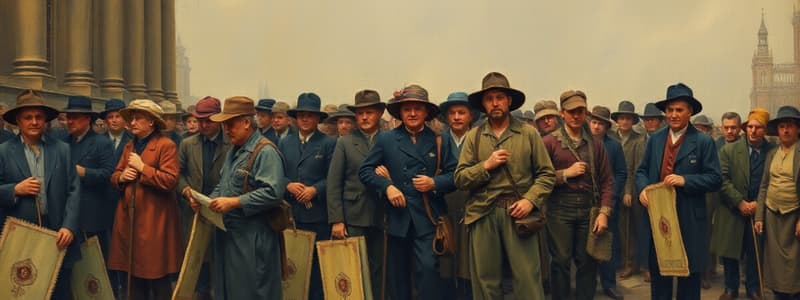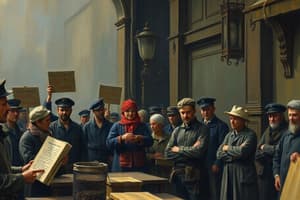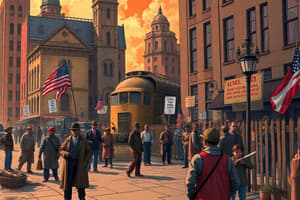Podcast
Questions and Answers
What was one of the primary goals of early labor unions in the 1800s?
What was one of the primary goals of early labor unions in the 1800s?
- To increase government regulation of businesses
- To improve wages to match the cost of living (correct)
- To create political parties for workers
- To establish a national workers' health care system
Which strike highlighted the struggles of workers in the late 19th century and drew national attention?
Which strike highlighted the struggles of workers in the late 19th century and drew national attention?
- The Philadelphia Carpenters’ Society Strike
- The Haymarket Affair
- The Great Railroad Strike of 1877 (correct)
- The Lowell Mill Girls Strike
What legal challenge did labor unions frequently face in the 1800s?
What legal challenge did labor unions frequently face in the 1800s?
- Being required to register as political organizations
- Mandatory memberships for all workers
- Unions were often viewed as conspiracies by the courts (correct)
- Prohibitions against strikes by government legislation
What significant event occurred due to the Haymarket Affair in 1886?
What significant event occurred due to the Haymarket Affair in 1886?
What was the National Trades’ Union known for?
What was the National Trades’ Union known for?
Which organization was founded in 1869 and aimed to unite all workers regardless of skill level, gender, or race?
Which organization was founded in 1869 and aimed to unite all workers regardless of skill level, gender, or race?
What concept did early labor unions lay the groundwork for through collective action?
What concept did early labor unions lay the groundwork for through collective action?
What was a common misconception about labor unions held by the public during the 1800s?
What was a common misconception about labor unions held by the public during the 1800s?
Flashcards are hidden until you start studying
Study Notes
Overview of Labor Unions in the 1800s
- Definition: Labor unions are organized groups of workers that aim to improve their working conditions, wages, and benefits.
Formation and Early History
- First Unions:
- Emerged in the late 18th century.
- Early groups formed by skilled workers (e.g., carpenters, shoemakers).
- Key Events:
- Formation of the Philadelphia Carpenters’ Society in 1827.
- The National Trades’ Union established in 1834 as the first national federation of unions.
Goals and Objectives
- Improved Wages: Seek higher pay to match cost of living.
- Better Working Conditions: Advocated for safety regulations and reasonable hours.
- Child Labor Reforms: Worked to end child labor and institute mandatory schooling.
- Support for Strikes: Unions organized strikes to demand rights and negotiate labor contracts.
Challenges Faced
- Legal Barriers: Courts often viewed unions as conspiracies and ruled against them.
- Employer Resistance: Businesses and factory owners opposed unions, often retaliating with dismissals or hiring non-union labor (scabs).
- Public Perception: Unions faced skepticism; seen as radical or disruptive to the economy.
Major Strikes and Conflicts
- The Lowell Mill Girls Strike (1834): Early example of organized labor by female workers demanding better conditions.
- Great Railroad Strike of 1877: Large-scale strike across the U.S. that drew national attention and highlighted the struggles of workers.
- Haymarket Affair (1886): Labor rally that turned violent, leading to a backlash against unions and associating them with radicalism.
Concept of Collective Bargaining
- Definition: The process of negotiation between employers and a group of employees aimed at agreements to regulate working conditions.
- Importance: While collective bargaining developed later, early unions laid groundwork for such practices by advocating collective action.
Key Organizations and Figures
- Knights of Labor: Founded in 1869; sought to unite all workers regardless of skill level, gender, or race.
- American Federation of Labor (AFL): Established in 1886, focused on skilled labor and practical goals such as higher wages and hours.
Legacy
- By the end of the 19th century, labor unions had begun to gain traction despite significant obstacles, setting the stage for future labor movements in the 20th century.
Labor Unions in the 1800s
- Labor unions emerged in the late 18th century as organized groups of workers aiming to improve working conditions, wages, and benefits.
- Early unions were formed by skilled workers, such as carpenters and shoemakers.
- The first national federation of unions, the National Trades’ Union, was established in 1834.
- Unions sought higher wages to match the rising cost of living, better working conditions, and an end to child labor.
- They also supported strikes to demand rights and negotiate labor contracts.
- Unions faced legal barriers, as courts often viewed them as conspiracies, and opposition from businesses who resisted their demands.
- Public perception of unions was often negative, seeing them as radical or disruptive to the economy.
- Key strikes include the Lowell Mill Girls Strike (1834), the Great Railroad Strike of 1877, and the Haymarket Affair (1886), which fueled backlash against unions.
- The concept of collective bargaining, negotiating between employers and employees, was pioneered by early unions, leading to future labor movements.
- The Knights of Labor, founded in 1869, aimed to unite all workers regardless of skill level, gender, or race.
- The American Federation of Labor (AFL), established in 1886, focused on skilled labor and practical goals such as higher wages and shorter hours.
- Despite significant challenges, labor unions began to gain traction by the end of the 19th century, laying the foundation for future labor movements in the 20th century.
Studying That Suits You
Use AI to generate personalized quizzes and flashcards to suit your learning preferences.




